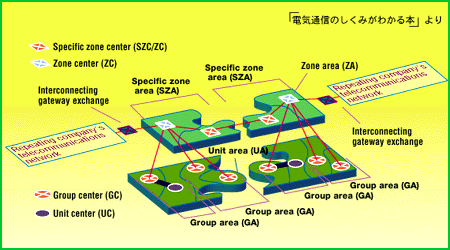 |
 |

 Digital Telephone Networks
Digital Telephone Networks |
 |

In principle, the digital network is based on a two-stage network hierarchy consisting of the subscriber's line exchange (local switch) that directly accommodates subscribers' lines and the trunk exchange that has only a trunk exchange function.
Subscriber system configuration
 Group center: GC
Group center: GC
- The group center is a switching office in the group area (GA) consisting of one or more unit areas (UAs). The group center incorporates a subscriber's line exchange and has a basic trunk to the zone center.
The group area is the unit of area providing a variety of services.
Note that, in the group area with a composite network configuration, the switching office incorporating a tandem exchange is referred to as a group tandem center (GMC).
 Unit center: UC
Unit center: UC
- Each unit area (UA) has a unit center, which is the switching office that serves as the basic element making up an area in the subscriber system. The unit center incorporates either a subscriber's line exchange that directly accommodates subscribers' lines or remote control switching equipment and has a basic trunk to the group center (GC).
Repeating system configuration
 Zone center: ZC
Zone center: ZC
- Each zone area (ZA) has a zone center, which is the switching office that serves as the basic element making up an area in the repeating system. The zone center incorporates a trunk exchange that focuses and repeats traffic from the group area (GA).
 Specific zone center: SZC
Specific zone center: SZC
- The specific zone center is a switching office in the specific zone area (SZA) for focusing and repeating traffic to and from the zone area (ZA). The specific zone center incorporates the trunk line exchange for the SZA.













 Group center: GC
Group center: GC
 Unit center: UC
Unit center: UC
 Zone center: ZC
Zone center: ZC
 Specific zone center: SZC
Specific zone center: SZC
